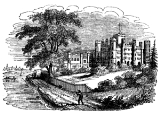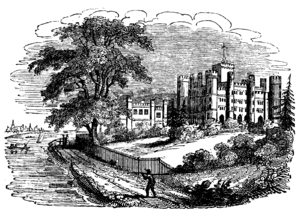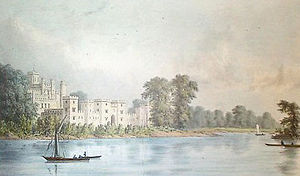
Kew Palace
Encyclopedia

Royal Botanic Gardens, Kew
The Royal Botanic Gardens, Kew, usually referred to as Kew Gardens, is 121 hectares of gardens and botanical glasshouses between Richmond and Kew in southwest London, England. "The Royal Botanic Gardens, Kew" and the brand name "Kew" are also used as umbrella terms for the institution that runs...
on the banks of the Thames up river from London. There have been at least four Palaces at Kew
Kew
Kew is a place in the London Borough of Richmond upon Thames in South West London. Kew is best known for being the location of the Royal Botanic Gardens, now a World Heritage Site, which includes Kew Palace...
, and three have been known as Kew Palace; the first building may not have been known as Kew as no records survive other than the words of another courtier. One survives and is open to visitors. It is cared for by an independent charity, Historic Royal Palaces
Historic Royal Palaces
Historic Royal Palaces is an independent charity created in 1998 to manage Britain's unoccupied royal palaces. These are:* The Tower of London* Hampton Court Palace* Kensington Palace - the state rooms only.* Banqueting House* Kew Palace...
, which receives no funding from the Government or the Crown.
The first Kew Palace
Not much is known of this building except that Queen Elizabeth IElizabeth I of England
Elizabeth I was queen regnant of England and Ireland from 17 November 1558 until her death. Sometimes called The Virgin Queen, Gloriana, or Good Queen Bess, Elizabeth was the fifth and last monarch of the Tudor dynasty...
gave this building to Robert Dudley
Robert Dudley, 1st Earl of Leicester
Robert Dudley, 1st Earl of Leicester, KG was an English nobleman and the favourite and close friend of Elizabeth I from her first year on the throne until his death...
, her childhood friend and court favourite. A letter from another of Elizabeth's courtiers suggests this to have been Dudley's main home near London, it's possible it might have also been called Leicester House.
The second Kew Palace
The old palace was built in 1631 by Samuel FortreySamuel Fortrey
Samuel Fortrey , was an English author.Fortrey was the author of ‘England's Interest and Improvement, consisting in the increase of the Store and Trade of this Kingdom,’ Cambridge, 1663...
.
The building formerly belonged to the Smith family, and by marriage became the property of Samuel Molyneux, Esq., secretary to George II
George II of Great Britain
George II was King of Great Britain and Ireland, Duke of Brunswick-Lüneburg and Archtreasurer and Prince-elector of the Holy Roman Empire from 11 June 1727 until his death.George was the last British monarch born outside Great Britain. He was born and brought up in Northern Germany...
.
Frederick, Prince of Wales
Frederick, Prince of Wales
Frederick, Prince of Wales was a member of the House of Hanover and therefore of the Hanoverian and later British Royal Family, the eldest son of George II and father of George III, as well as the great-grandfather of Queen Victoria...
took a long lease of the house, which he made his frequent residence; and here, too, occasionally resided his favourite poet, James Thomson, author of "The Seasons." In 1738, another poet, Alexander Pope
Alexander Pope
Alexander Pope was an 18th-century English poet, best known for his satirical verse and for his translation of Homer. He is the third-most frequently quoted writer in The Oxford Dictionary of Quotations, after Shakespeare and Tennyson...
, gave Prince Frederick a dog, with the following verse inscribed on its collar:
- I am His Highness' dog at Kew.
- Pray tell me, sir, whose dog are you?
The house contained some good pictures, among which were a set of Canaletto
Canaletto
Giovanni Antonio Canal better known as Canaletto , was a Venetian painter famous for his landscapes, or vedute, of Venice. He was also an important printmaker in etching.- Early career :...
's works; the celebrated picture of the Florence gallery, by Zoffany
Johann Zoffany
Johan Zoffany, Zoffani or Zauffelij was a German neoclassical painter, active mainly in England...
, (who resided in the neighbourhood). The pleasure-grounds, which contained 120 acre (0.4856232 km²), were laid out by Sir William Chambers
William Chambers (architect)
Sir William Chambers was a Scottish architect, born in Gothenburg, Sweden, where his father was a merchant. Between 1740 and 1749 he was employed by the Swedish East India Company making several voyages to China where he studied Chinese architecture and decoration.Returning to Europe, he studied...
, one of the greatest masters of ornamental English gardening.
The third Kew Palace

James Wyatt
James Wyatt RA , was an English architect, a rival of Robert Adam in the neoclassical style, who far outdid Adam in his work in the neo-Gothic style.-Early classical career:...
. Commenced in 1802, it was a gothic
Gothic architecture
Gothic architecture is a style of architecture that flourished during the high and late medieval period. It evolved from Romanesque architecture and was succeeded by Renaissance architecture....
"castellated palace" which attracted little praise, being considered too silly for a patron of his standing. After the King’s confinement at Windsor, Queen Charlotte
Charlotte of Mecklenburg-Strelitz
Charlotte of Mecklenburg-Strelitz was the Queen consort of the United Kingdom as the wife of King George III...
declined to occupy the new building. It was demolished during the reign of her son George IV
George IV of the United Kingdom
George IV was the King of the United Kingdom of Great Britain and Ireland and also of Hanover from the death of his father, George III, on 29 January 1820 until his own death ten years later...
in 1828.
Innumerable are the instances of princes having sought to perpetuate their memories by the building of palaces, from the Domus Aurea
Domus Aurea
The Domus Aurea was a large landscaped portico villa, designed to take advantage of artificially created landscapes built in the heart of Ancient Rome by the Emperor Nero after the Great Fire of Rome had cleared away the aristocratic dwellings on the slopes of the Palatine...
, or golden house of Nero, to the comparatively puny structures of our own times. As specimens of modern magnificence and substantial comfort, the latter class of edifices may be admirable; but we are bound to acknowledge, that in boldness and splendour of design, they cannot assimilate to the labours of antiquity, much of whose stupendous character is to this day preserved in many series of interesting ruins
Ruins
Ruins are the remains of human-made architecture: structures that were once complete, as time went by, have fallen into a state of partial or complete disrepair, due to lack of maintenance or deliberate acts of destruction...
:—
- Whilst in the progress of the long decay,
- Thrones sink to dust, and nations pass away.
As a record of this degeneracy, near the western corner of Kew Green stands the palace, commenced for George III
George III of the United Kingdom
George III was King of Great Britain and King of Ireland from 25 October 1760 until the union of these two countries on 1 January 1801, after which he was King of the United Kingdom of Great Britain and Ireland until his death...
, under the direction of the late James Wyatt
James Wyatt
James Wyatt RA , was an English architect, a rival of Robert Adam in the neoclassical style, who far outdid Adam in his work in the neo-Gothic style.-Early classical career:...
, Esq. The north front possesses an air of solemn, sullen grandeur; but it very ill accords with the taste and science generally displayed by its nominal architect.
To quote the words of a contemporary, "this Anglo-Teutonic, castellated, gothized structure must be considered as an abortive production, at once illustrative of bad taste and defective judgment. From the small size of the windows and the diminutive proportion of its turrets, it would seem to possess
- "Windows that exclude the light,
- And passages that lead to nothing."
Upon the unhappy seclusion of the royal architect, the works were suspended, and it remained unfinished. Censure and abuse have, however, always been abundantly lavished on its architecture, whether it be the result of royal caprice or of professional study; but the taste of either party deserves to be taxed with its demerits.

Brentford
Brentford is a suburban town in west London, England, and part of the London Borough of Hounslow. It is located at the confluence of the River Thames and the River Brent, west-southwest of Charing Cross. Its former ceremonial county was Middlesex.-Toponymy:...
, "I do like this place, it's so like Yarmany."
Sir Richard Phillips (1767–1840), in "A Morning's Walk from London to Kew," (1817) characterized the new palace as "the Bastile palace, from its resemblance to that building, so obnoxious to freedom and freemen. On a former occasion," says he, "I have viewed its interior, and I am at a loss to conceive the motive for preferring an external form, which rendered it impracticable to construct within it more than a series of large closets, boudoirs, and rooms like oratories." The latter part of this censure is judiciously correct; but the epithet "bastile" is perhaps too harsh for some ears.
The premature fate of Kew Palace render it at this moment an object of public curiosity; while the annexed engraving may serve to identify its site, when posterity
- "Asks where the fabric stood."
The fourth Kew Palace
.jpg)
Richard Levett
Sir Richard Levett , Sheriff, Alderman and Lord Mayor of London, was one of the first directors of the Bank of England, an adventurer with the London East India Company and the proprietor of the trading firm Sir Richard Levett & Company. He had homes at Kew and in London's Cripplegate, close by...
, a powerful merchant and the former Lord Mayor of the City of London, who had purchased it from the grandson of the original owner, a Dutch merchant who had built the house in 1663.
Originally from Sussex, the Levett
Levett
Levett is an Anglo-Norman territorial surname deriving from the village of Livet-en-Ouche, now Jonquerets-de-Livet, in Eure, Normandy. Ancestors of the earliest Levett family in England, the de Livets were lords of the village of Livet, and undertenants of the de Ferrers, among the most powerful of...
family (whose name derives from the village of Livet
Livet
Livet is a commune in the Mayenne department in north-western France.Livet is also:* Eugène Livet, founder of the institution Livet, now lycée Eugène-Livet .* Several former towns in France were named Livet.-See also:...
in Normandy) retained ownership of the house, as well as other lands in the Kew complex, until October 13, 1781, when the Dutch House was purchased by King George III
George III of the United Kingdom
George III was King of Great Britain and King of Ireland from 25 October 1760 until the union of these two countries on 1 January 1801, after which he was King of the United Kingdom of Great Britain and Ireland until his death...
from the Levett family for £20,000. But members of the Royal Family had occupied the house as early as 1734, when they leased the house from the Levett heirs. (A map of 1771 delineated the land between the Dutch House and the river as belonging to barrister Levett Blackborne, Lincoln's Inn
Lincoln's Inn
The Honourable Society of Lincoln's Inn is one of four Inns of Court in London to which barristers of England and Wales belong and where they are called to the Bar. The other three are Middle Temple, Inner Temple and Gray's Inn. Although Lincoln's Inn is able to trace its official records beyond...
barrister and grandson of Sir Richard Levett.) Indeed a musical portrait of the cello-playing Frederick, Prince of Wales
Frederick, Prince of Wales
Frederick, Prince of Wales was a member of the House of Hanover and therefore of the Hanoverian and later British Royal Family, the eldest son of George II and father of George III, as well as the great-grandfather of Queen Victoria...
(son of George II) and his sisters, part of the National Portrait Gallery collection in London, painted oil on canvas by Philip Mercier
Philip Mercier
Philip Mercier was a portraitist active in England.Painter of portraits and a pioneer in England of conversation piece and ‘fancy pictures’; an important figure in the introduction of French taste into England.-Life:Born in France to a tapestry worker of French Huguenot stock working for the...
and dated 1733, uses the house as its plein-air backdrop. In 1735 the architect William Kent
William Kent
William Kent , born in Bridlington, Yorkshire, was an eminent English architect, landscape architect and furniture designer of the early 18th century.He was baptised as William Cant.-Education:...
produced a grandiose plan for a large Palladian palace at Kew, very much in the style of Stowe
Stowe, Buckinghamshire
Stowe is a civil parish and former village about northwest of Buckingham in the Aylesbury Vale district of Buckinghamshire, England. The parish includes the hamlets of Boycott, Dadford and Lamport....
but this was never executed.

The new palace was intended to be "a late Georgian Nonsuch
Nonsuch Palace
Nonsuch Palace was a Tudor royal palace, built by Henry VIII in Surrey, England; it stood from 1538 to 1682–3. Its ruins are in Nonsuch Park.- Background :Nonsuch Palace in Surrey was perhaps the grandest of Henry VIII's building projects...
". However the new palace was far from complete in 1810 when the King's insanity forced him to retire from public life. The new palace's style was not to the taste of his successor the profligate George
George IV of the United Kingdom
George IV was the King of the United Kingdom of Great Britain and Ireland and also of Hanover from the death of his father, George III, on 29 January 1820 until his own death ten years later...
, the Prince Regent
Prince Regent
A prince regent is a prince who rules a monarchy as regent instead of a monarch, e.g., due to the Sovereign's incapacity or absence ....
. In 1828 parliament having studied the accounts ordered the shell to be demolished, and such fixture and fitting as had been installed to be used elsewhere in royal residences. The staircase was in fact later used at Buckingham Palace
Buckingham Palace
Buckingham Palace, in London, is the principal residence and office of the British monarch. Located in the City of Westminster, the palace is a setting for state occasions and royal hospitality...
.
George III's wife, Queen Charlotte
Charlotte of Mecklenburg-Strelitz
Charlotte of Mecklenburg-Strelitz was the Queen consort of the United Kingdom as the wife of King George III...
died at the Dutch House on November 17, 1818.
On ascending the throne in 1837 Queen Victoria gave most of Kew Gardens to the nation, retaining only a small summer house once belonging to Queen Charlotte for her own use. Known as "Queen's Cottage" Queen Victoria seldom visited it and to mark her Golden Jubilee
Golden Jubilee
A Golden Jubilee is a celebration held to mark a 50th anniversary.- In Thailand :King Bhumibol Adulyadej, the world's longest-reigning monarch, celebrated his Golden Jubilee on 9 June 1996.- In the Commonwealth Realms :...
in 1887 she presented this also to the country.
Restoration of Kew Palace

Manor house
A manor house is a country house that historically formed the administrative centre of a manor, the lowest unit of territorial organisation in the feudal system in Europe. The term is applied to country houses that belonged to the gentry and other grand stately homes...
. Kew Palace was used to hold a dinner hosted by Charles, Prince of Wales
Charles, Prince of Wales
Prince Charles, Prince of Wales is the heir apparent and eldest son of Queen Elizabeth II and Prince Philip, Duke of Edinburgh. Since 1958 his major title has been His Royal Highness The Prince of Wales. In Scotland he is additionally known as The Duke of Rothesay...
to celebrate the 80th birthday of Elizabeth II on April 21, 2006. A few days later it reopened as a visitor attraction, following a ten year closure for restoration.
The restoration
Building restoration
Building restoration describes a particular treatment approach and philosophy within the field of architectural conservation. According the U.S...
not only included physical restoration to the building, but also weaving of period draperies and other fabric décor carried out by master weaver Ian Dale of Scotland
Scotland
Scotland is a country that is part of the United Kingdom. Occupying the northern third of the island of Great Britain, it shares a border with England to the south and is bounded by the North Sea to the east, the Atlantic Ocean to the north and west, and the North Channel and Irish Sea to the...
. An external lift shaft was added on the west wing for disabled access, in the place of a tower which housed three floors of lavatories.
The Palace was featured in the BBC documentary series Tales from the Palaces
Tales from the Palaces
Tales from the Palaces is a British television documentary series following the conservation teams inside Britain's Historic Royal Palaces: Hampton Court, The Tower of London, Kensington Palace, The Banqueting House and Kew Palace. It is produced by BBC and has been shown worldwide including in...
.

